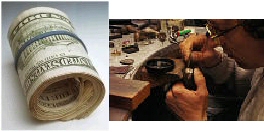Here are the top 10 mistakes people make when pricing repairs:
1. Thinking of repairs as being price-sensitive
similar to the way jewelry products are.
Customers come to you because they trust
you. Want proof? Answer this simple test: Out
of 10 people who look in the case, how many
buy? (Average is two or three out of 10). Out of
10 people who ask if you can repair something,
how many leave it? (Average is nine out of 10).
There you go! It’s not price-sensitive.
2.Making the price up in mid-air and speaking
it orally. “That will run you about $45.” Bad
news, the customer might say, “Gosh, that
sounds like a lot, can’t you do better?” Okay, if
you hold your ground, fine. But what if you
lower the price? Know what that means? The
jeweler has to either work faster or clock out
while doing the job because you’d lowered the
price. The shop can’t make money this way.
Your second problem is it’s come out of your
mouth. Basic psychology: People are apprehensive
about what they hear, and believe what
they see.
Have all prices written down so you
can refer to the particular repair they request.
Our 300-page price book got us to the level
where when we pointed and said, “$85.00”,
they just said, “Okay.”
3. Not having bi-monthly sales meetings
where you train the staff a little at a time on
how repairs are actually priced. Lessons over
time go a long way towards having a terrific
staff. We spent nine months training our
staff. Start today.
4. Asking your jeweler, “How much should
we charge?” Ever notice how a jeweler calls
home and says, “Honey, I’ll be about 45 minutes
minutes late ...” and he shows up two hours later?
Jewelers can’t judge time well. So how can we
expect them to be able to price well?
The solution is simple — ask the jeweler how long he
thinks it will take, double that amount and
multiply that new number by at least $65 per
hour. Our shop figured its time at
$100 per hour, but we used a longer
timeframe for the time multiplier.
Also, most bench jewelers can’t
imagine getting $100 for what “just
took them an hour”.
5. Calling the customer back later
with an estimate. Whether it’s a
repair or a custom job, there’s no
real reason why you can’t price it
now. Besides, the customer will lose
their enthusiasm ... so strike while
the iron is hot. And stop wasting
your time and theirs. Quote now.
6. Prejudging that a customer
won’t pay for a repair because you
think that they will think the price
is way more than the item is worth.
It is not your place to decide a customer
won’t spend the money. Don’t go
and charge $45 for fixing a cheap ring just
because it’s cheap, if it will take the 1.5 hours
you would normally charge $150 for. If you
charge $150 to fix an $800 ring, but only $45
to fix a $200 ring, then logically you should
charge $400 for the same 1.5 hours on a
$4,000 ring. You may like the idea of charging
more on higher items to make up for lowerpriced
repairs. But charge consistently, you’ll
come out better.
7. Not offering what the item really needs
because you think, you’ve “charged enough”
already. I know one store in California where
they simply won’t answer the simple question,
“How much to size my ring down?” They
instead take the ring to the microscope and
write down what it needs. About 90 percent of
their customers follow the objective advice.
Their average repair is $95.
8. Not paying commissions on repairs. This is
one of the silliest of all! It takes one person to
sell a $2,000 showcase item in 15 to 30 minutes.
It takes four people to sell a $25 repair in
the same amount of time! It takes a salesperson
to sell it, someone to log it in and order a
part, a jeweler to fix it and a salesperson to
deliver it. Four people for $25! I wouldn’t like
repairs either if I wasn’t compensated
for selling them. Besides, if the jeweler
cost you $3 and you received $10 to do
the job, isn’t that profitable?
9. Not telling the customer about
your warranty. Believe it or not, you
have warranted your workmanship,
even though you didn’t speak the
words. Tell the customer you warranty
your work; it will help you get those
higher prices more easily.
10. Not offering your customers rush
service. Customers want the convenience
of while-you-wait or fast service.
In our price book is an “Express
Service” column. It’s 50 percent higher
and we’ll do any repair while you
wait or within 24 hours. About 40
percent of the customers take us up
on it! And this particular service generates
the least complaints!
You can make more gross profit dollars as a
percentage from the shop than you can from
the case. Customers will pay for convenience
and quality and trust.
David Geller
www.JewelerProfit.com
P.S. Is your Geller Repair Pricing Guide Up To Date?
If you have a spiral bound Geller book (not the 3 ring binder),
Version 1.0; 2.0; 3.0; 3.2; 4.0
then you need to upgrade. Go here to upgrade your Geller Book:
http://www.jewelerprofit.com/Products/Upgrade.html


